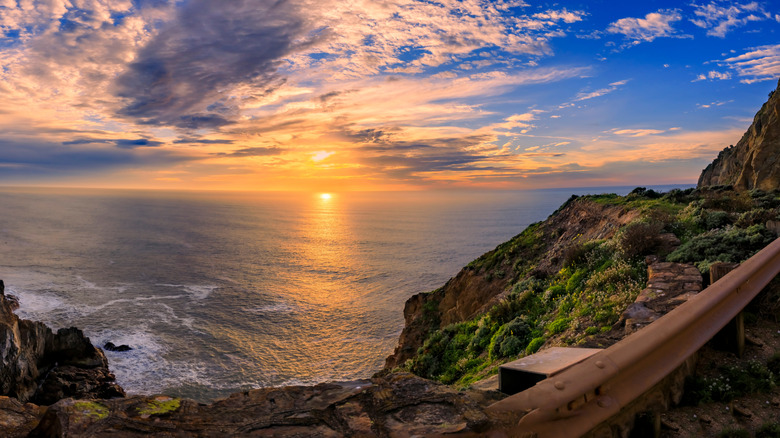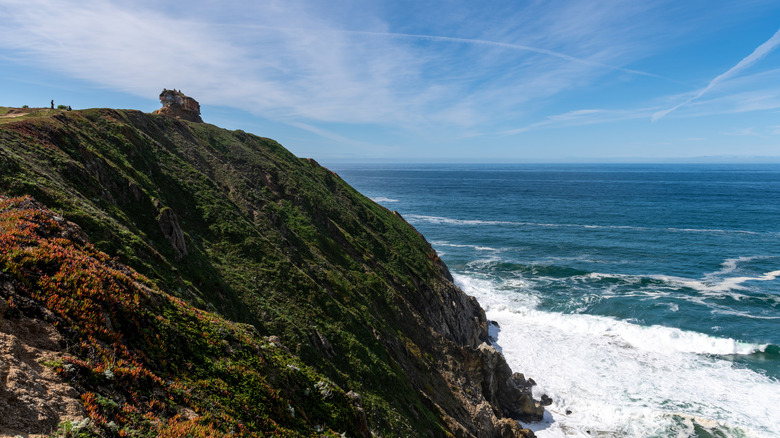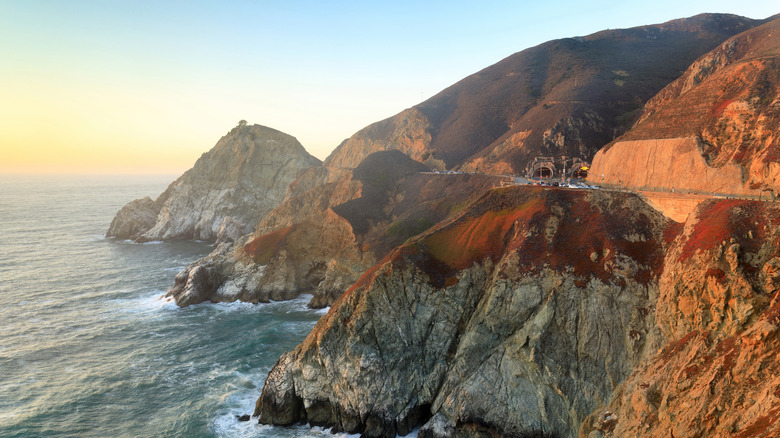The Only Stretch Of California's Iconic Highway 1 Closed To Cars Has World-Class Coastline Views
Road tripping along California's Highway 1 takes you to striking cities and beaches, but there's one part of the highway where cars aren't allowed and you can get out and walk. That's the Devil's Slide Trail, a 1.3-mile stretch of California's Highway 1, right along a cliff's edge overlooking the ocean. Well, it used to be Highway 1. About a 25-minute drive north from Half Moon Bay, an underrated California beach town where you can escape the crowds, and about the same distance south from downtown San Francisco, this short section of the iconic highway was closed to cars in 2013. The following year, it opened for pedestrians and cyclists, allowing people to enjoy the unparalleled views of this part of San Mateo County.
This stretch of Highway 1-turned-trail runs along the western flank of San Pedro Mountain as it meets the Pacific Ocean. Even before Highway 1 was finished in the 1930s, the area was known for being difficult and even dangerous to traverse. This is what gave the region its name. Not long after the highway opened, the Devil's Slide portion was closed because of a landslide. And that would happen over and over again. After hundreds of millions of dollars and years of debate, cars now go through the mountains via the Tom Lantos Tunnels, the second longest tunnels in California. That left this portion of the highway still paved and able to be fairly easily turned into a park-slash-trail that highlights the coast's wild beauty.
Geology, biology, and military history: find them all on the Devil's Slide Trail
Walking the Devil's Slide Trail gives you a glimpse into the uniqueness of California coastal geology. There are sedimentary layers that were once the bottom of the ocean, and there's also sparkly granite that's the same rock that you'll find in the Sierra Nevada mountains.
The Devil's Slide Trail gives you a chance to see all kinds of wildlife. There are observation scopes along the trail; however, you might want to bring your own binoculars. You could see migrating gray whales and other sea creatures out in the water, along with plenty of birds. Egg Rock, which you can see from the trail, is a protected promontory just off the coast where there's a breeding colony of common murres, which look a bit like penguins.
Along the trail, you'll also notice a graffitied cement structure near the edge of the cliff. It's the remnants of a World War II bunker, where the military would keep an eye out for potential approaching enemy ships. It's now on private property, and while you can't explore it, it makes for an interesting juxtaposition of human-made history seemingly teetering on the edge of the continent.
What to know before you visit the Devil's Slide Trail
The Devil's Slide Trail is an out-and-back route, and it does have some ups and downs, though nothing too tough. There are benches along the way, where you can stop to rest and take in the views of the Pacific Ocean, and along with stunning vistas, the trail has drinking fountains and restrooms. Since it's right along the cliff, it can be breezy and cool (even if your hike started out warm and sunny), so make sure to bring layers. It can also be foggy, which can limit how much you can see, but it's still a pretty trail.
There are parking lots at each end of the trail, which open at 8 a.m. every day. They close as early as 5 p.m. during winter, and as late as 8 p.m. during the height of summer; the lots can fill up quickly, particularly on nice days. So, if you're visiting on a weekend, take advantage of the free shuttle service out of the nearby town of Pacifica.
If you've worked up an appetite after your time on the trail, you should definitely check out the world's most beautiful Taco Bell in Pacifica. It's just about a five-minute drive from the Devil's Slide. And for another Bay Area site with military history and great views, Hawk Hill in the Marin Headlands overlooks the Golden Gate Bridge and San Francisco Bay, and it has some unfinished World War II batteries.


